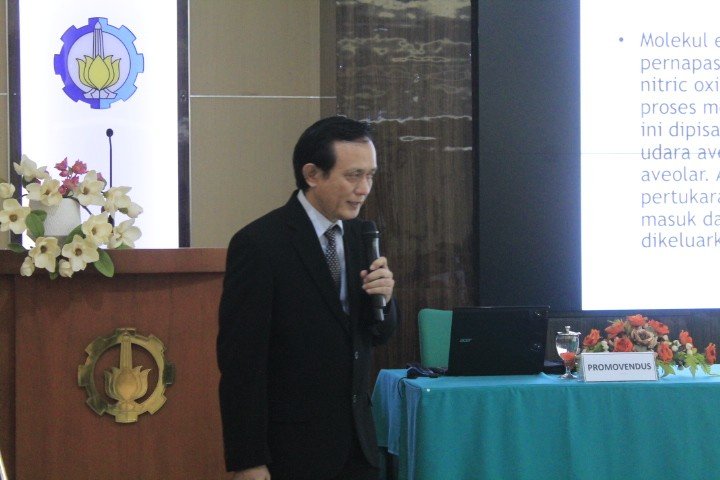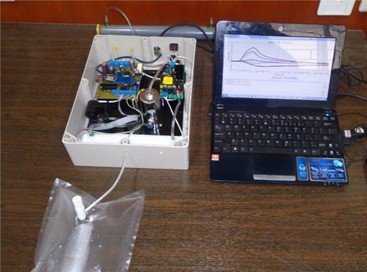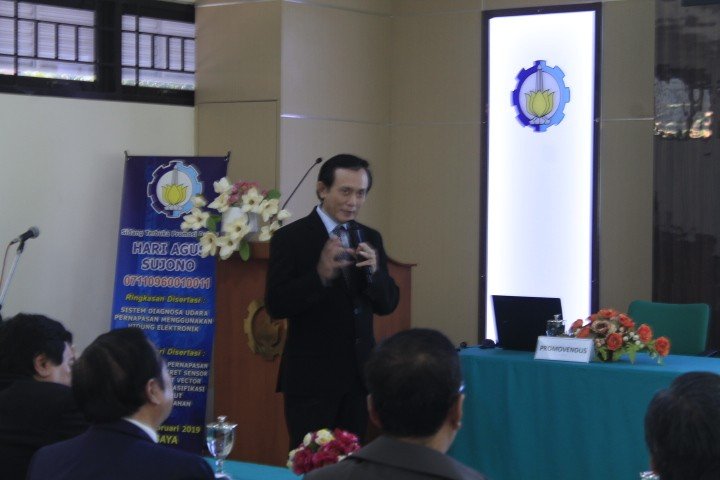Easy Detection of Asthma with Electronic Nose

Dr. Ir Hari Agus Sujono MSc when presenting the results of his dissertation at an open session of his doctoral promotion at ITS Electrical Engineering
ITS Campus, ITS News – Diagnosis of asthma using Gas Chromatography (GC) is very expensive. This condition inspired Dr. Ir Hari Agus Sujono MSc to develop a diagnosis method of breathing air using Electronic Nose in his doctoral dissertation at the Department of Electrical Engineering, Institut Teknologi Sepuluh Nopember (ITS), Surabaya.
In fact, Hari claimed the results of research conducted since 2009 were able to save up to 90 percent the cost of diagnosing asthma. He explained, until now the development of medical monitoring technology and commonly used diagnostic methods were still based on the composition of body fluids such as blood and urine. “Although this method has a very high accuracy and affordable costs, it requires a long and dangerous time for patients and workers,” said the man who also obtained his bachelor degree at ITS.
Another diagnostic method that is currently developing is the respiratory air diagnostic method. This method utilizes air samples taken from patients which are then analyzed to determine changes in concentration of certain compounds. At present, diagnosing breathing air requires GC, which can discriminate and identify molecules in the gas mixture.
This man born in Kediri regretted the costs that must be spent to diagnose using this method. It can cost up to tens of millions rupiah, and according to him the cost is very expensive. In addition, the sampling and testing process is also complicated.

The Electronic Nose Device developed in the dissertation of Dr. Ir Hari Agus Sujono MSc
Therefore, under the guidance of Dr. Muhammad Rivai ST MT and Prof. Dr. Muhammad Amin dr SpP(K), this permanent lecturer at the Adhi Tama Institute of Technology Surabaya (ITATS) proposed another alternative that’s cheaper and portable, namely Electronic Nose. “By using series of gas sensor and Support Vector Machine (SVM), this system is able to work quickly in imitating the workings of humans,” he claimed.
Hari explained, the Electronic Nose he developed in this study used seven types of Metal Oxide Semiconductor (MOS) gas sensors, including carbon dioxide (CO2), Carbon Monoxide (CO), Hydrogen (H2), NO, H2S, NH3, and VOC. “Each sensor used to detect compounds in breathing air which indicate the presence of asthma in the subject,” he explained.
This tool, continued Hari, operates in three stages to produce a total sensor response for a total of 150 seconds. “These results are certainly faster than diagnoses using GC that takes several days,” he said.
In addition, according to Hari, with this tool the costs incurred by patients can be reduced up to 90 percent. However, Hari also realized that the tools he developed still needed a lot of improvement, especially on the sensitivity and selectivity of the sensors used.
Hari hopes that the tools he develops can be optimized so they can be immediately used by the society and able to provide information about the condition of patients suffering from asthma more accurately and certainly at affordable costs. (Rur / HUMAS ITS)

Dr. Ir Hari Agus Sujono MSc is a lecturer at the Adhi Tama Institute of Technology in Surabaya (ITATS)
Related News
-
ITS Collaboration with BPBD East Java, Launching VR Disaster Simulation
ITS Campus, ITS News — Supporting anticipation of disasters and continuing to educate the public, Institut Teknologi Sepuluh Nopember
February 25, 2019 13:02 -
Supporting the Implementation of Innovative Ideas, ITS and IYSA Hold International Competition
ITS Campus, ITS News — Institut Teknologi Sepuluh Nopember (ITS) has once again proven its commitment to supporting the
February 25, 2019 13:02 -
ITS Maintains Informative Qualification for Five Consecutive Years at KIP Awards
ITS Campus, ITS News — Institut Teknologi Sepuluh Nopember (ITS) has once again successfully maintained its Informative Qualification predicate
February 25, 2019 13:02 -
ITS Strengthens Smart Eco-Campus through UI GreenMetric 2024
ITS Campus, ITS News — Institut Teknologi Sepuluh Nopember (ITS) has once again demonstrated its commitment to environmental concern
February 25, 2019 13:02
